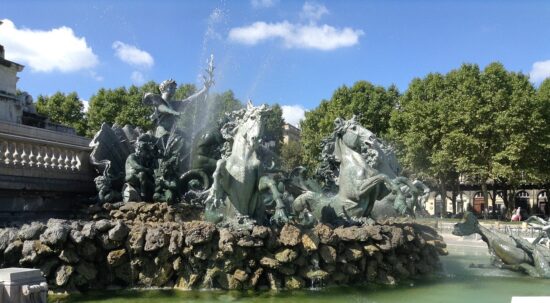Place des Quinconces
The largest square in Western Europe & Bordeaux’s pride & joy, the Place des Quinconces got its name from the geometrical pattern of the trees planted in the square forming a quincunx meaning a shape like that of a five in a dice. The square was built in the place of the demolished Castle Trompet & is today characterized by the Girondist Column, the monumental pillar dedicated to the revolutionary group formed during the French Revolution in Bordeaux.
Place des Quinconces was created in ten years, from 1818 to 1828, on the area formerly occupied by Château Trompette. In 1816 by royal order, Louis XVIII had handed over to the municipality the property of the Chateau Trompette, a vast fortress built in the 15th century by one of his predecessors, to establish the authority of the Kings of France over Bordeaux taken over from the English. The municipality took responsibility for the demolition and development of the land. The whole, which has been compared to the Esplanade des Invalides in Paris, forms a public area of more than twelve hectares, making it the largest square in Europe.
In front of a hemicycle, the esplanade is a terrace which gradually catches up with the slope of the land, overhanging the quay to which one descends by monumental stairs. Alleys, promenades planted with trees, extend on each side slightly below. The square also houses the colossal white marble statues of Montaigne and Montesquieu sculpted by Dominique Fortuné Maggesi.


In the Neo-classical style, they were built by Pierre-Alexandre Poitevin in 1828, at the eastern end of Place des Quinconces. Twenty-one meters high, each column was decorated in the lower third, by the Italian decorator N. Bonino, with four prows of galleys extended by rostrums formed by two bundles of three swords. The rostrums recall the victory of the Roman fleets over those of Carthage and, since Antiquity, signify the triumphal mastery of the seas.
It was not until 1883, after many other projects, that the decision was taken to erect a monument to the Girondins and the Republic on the Place des Quinconces. It took fifteen years to do it. The famous Column of the Girondins , 43 meters high, erected in 1895 by Dumilâtre and Rich, is surmounted by a Statue of Liberty.
At the foot of the column were erected the statues of the city of Bordeaux, the Garonne and the Dordogne but the Girondin deputies are lacking. sea horses and the bronze groups placed at the level of the side basins, removed under the German occupation, during the Second World War, were solemnly put back in place in 1985. Protected since 2002 as historical monuments, the column has been security work and heritage restoration work in 2006.


The bronze statue on the top of the column depicting Liberty, the Gallic rooster at its base, one of the main French symbols, the stunning fountains of the sea-horse drawn chariots, along with the two other neo-classical columns dedicated to trade & navigation & the statues of Montaigne & Montesquieu, the two influential writers of the French Renaissance complete the puzzle of this amazing square.



